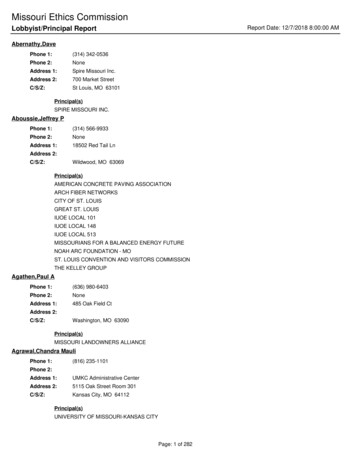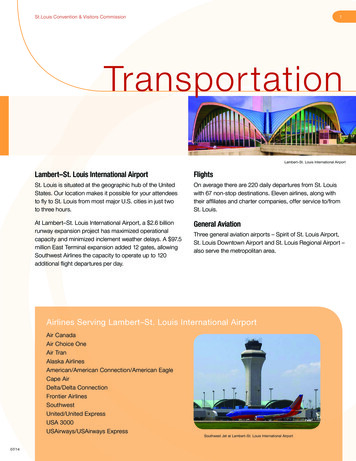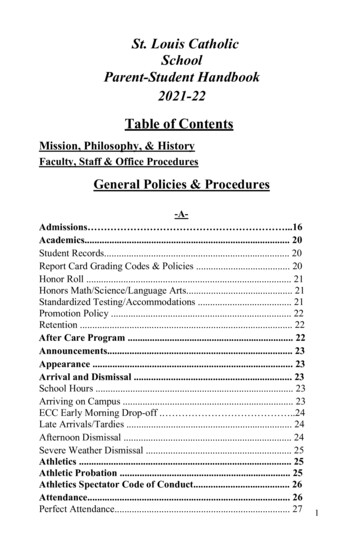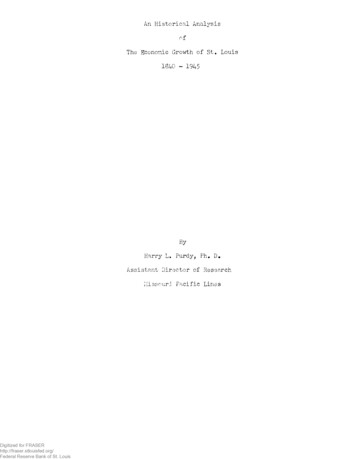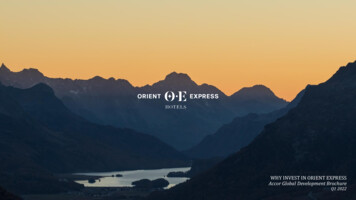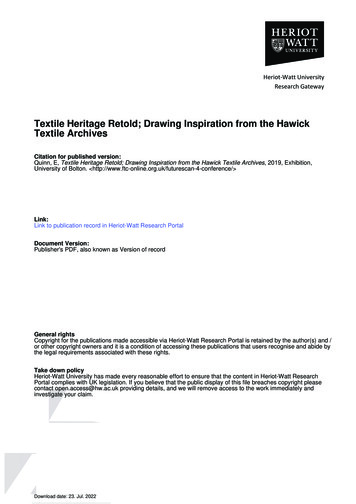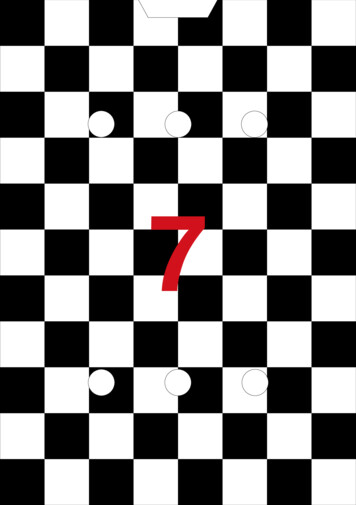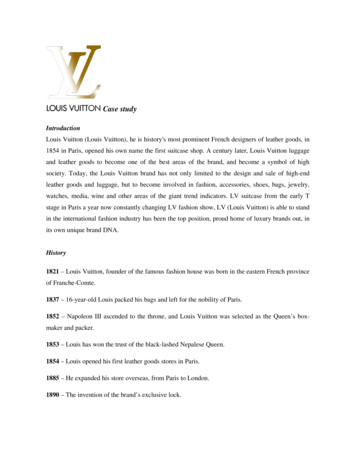
Transcription
Case studyIntroductionLouis Vuitton (Louis Vuitton), he is history's most prominent French designers of leather goods, in1854 in Paris, opened his own name the first suitcase shop. A century later, Louis Vuitton luggageand leather goods to become one of the best areas of the brand, and become a symbol of highsociety. Today, the Louis Vuitton brand has not only limited to the design and sale of high-endleather goods and luggage, but to become involved in fashion, accessories, shoes, bags, jewelry,watches, media, wine and other areas of the giant trend indicators. LV suitcase from the early Tstage in Paris a year now constantly changing LV fashion show, LV (Louis Vuitton) is able to standin the international fashion industry has been the top position, proud home of luxury brands out, inits own unique brand DNA.History1821 – Louis Vuitton, founder of the famous fashion house was born in the eastern French provinceof Franche-Comte.1837 – 16-year-old Louis packed his bags and left for the nobility of Paris.1852 – Napoleon III ascended to the throne, and Louis Vuitton was selected as the Queen’s boxmaker and packer.1853 – Louis has won the trust of the black-lashed Nepalese Queen.1854 – Louis opened his first leather goods stores in Paris.1885 – He expanded his store overseas, from Paris to London.1890 – The invention of the brand’s exclusive lock.
1896 – Louis Vuitton’s son George took the shorthand of his father’s name, L and V, andintertwined it with a flower pattern design creating the renowned monogram canvas still wellknown today.1900 -George diversified their classic trunk and introduced hanging clothes, luggages, shoes, hatboxes.1914 – The world’s largest leather goods store opened in Champs Elysees, Paris. The store becamethe flagship of the brand, expanding a worldwide sales network.1932 – LV’s bucket bag made its formal debut.1984 – More stores opened in Paris and New York.1987 – The acquisition of VeuveClicquot Group, the Group owns VeuveClicquot champagne andGivenchy perfume. In September of the same year, LV and Hennessy merged to become theworld’s largest boutique group LVMH (LouisVuittonMoetHennessy).1996 – To celebrate the centennial of the Monogram series, LV invited seven designers to design alimited edition.1998 – Clothing master Marc Jacobs was invited to join the team; he created the much publicizedVernis Line.2003 – The collaboration of Louis Vuitton and Japanese artist Takashi Murakami brought a colorfulexpression to its collection.
The Louis Vuitton CompanyFounded in 1854, the Louis Vuitton Company was soon to become one of the world’s most famousmakers of luxury goods. Creator of high quality travel trunks and leather accessories, the companywas above all known for its designer luggage pattern, a beige monogram, LV, on a chestnutbackground. After his father’s death in 1892, George Vuitton took over the company, taking it tonew heights in developing what was recognized as the first "designer label" on a product.When Marc Jacobs in 1998 assumed the role as Artistic Director, Louis Vuitton entered the worldof high fashion. Commissioning artists such as Stephen Sprouse and Takashi Murakami, LouisVuitton was able to lend their cutting-edge design ideas for their signature products, creating musthave status symbols. Today Louis Vuitton is a world leader in luxury customer goods, includingtravel books, perfumes, distilled spirits and designer shoes and clothing.Like several others luxury and prestige brands launched in the 19th and early 20th centuries, LouisVuitton started out with providing luxury products exclusively for the very wealthy people ofsociety. Even though times have changed and the market for this kind of products has increasedenormously Louis Vuitton still targets its products at consumers on the top-end of the wealthspectrum. These are price insensitive consumers allowing the company to charge thousands ofdollars for one item.According to Uche Okonkwo, creativity exclusivity, craftsmanship, precision, high quality,innovation and premium pricing are product attributes that not only give the consumer thesatisfaction of owning expensive items but the extra-added psychological benefits like prestige anda sense of high status that reminds them and others that they belong to an exclusive group of aselected few, who can afford pricy items. Furthermore, Okonkwo means that this kind of luxurybrands need to have strategies that address the difficult paradox of the combination of exclusivityand availability and to appeal to many while appearing to be right for only a special few.This statement rather well describes the Louis Vuitton Company’s desired positioning, in givingemphasis to the contrast between tradition and modernity in the company philosophy. Because ofits long and proud history of high qualitative craftsmanship, tradition in combination withmodernity and proven innovation, excellence and creativity, comprises an important part of thebrand identity of the company. The statements “For Louis Vuitton, the art of travel is the art of fineliving” shows that the company brand identity also has a very strong connection to its heritage eventhough it was a long time since the Louis Vuitton brand comprised exclusively of travel goods. Yet
another proof of that can be found at the Louis Vuitton official website where you can get tips abouthow to pack your luggage or visit a virtual travel museum.Brand strategyLVMH Moët Hennessy CEO Bernard Arnault recently told the Financial Times, “What interestsme is that in 15 years’ time, Louis Vuitton is still the leading luxury brand.” Louis Vuitton has beenreinforcing its position within the high-end segment of the luxury market and balancing its massiveglobal presence with the objective of leveraging luxury and exclusivity. To prevent the risk ofoverexposure, the brand is concentrating on limiting its own visibility. The monogrammed productthat has helped Louis Vuitton to attain its strong status with global consumers is becomingsynonymous with accessible luxury. The 2013 LVMH “Les Journées Particulières” event allowedthe Louis Vuitton brand to highlight its craftsmanship. The brand has also been focusing onsatisfying consumers’ desire for customization and has succeeded in expanding its position in thefast-growing timepieces market and jewelry. It plans to launch its exclusive LV fragrance fromMaster Perfumer Jacques Cavallier-Belletrud next year, as well as new stores, with openings limitedto key countries. Additionally, Louis Vuitton has opened two new iconic stores. One is dedicatedexclusively to luxury jewels and is located in Place Vendôme and the second is its first “Cabinetd’Écriture” on the Place Saint-Germain-des-Prés in Paris, constructing deeper and more substantiveengagement and storytelling around the art of writing. The brand recorded outstanding resultsbecause of its ability to move into a more high-end segment of the luxury market.
SWOT AnalysisSTRENGTHS WEAKNESSESBrand name and brand recognitionStrong overall market share within theluxury segment, with 60%Products are viewed as an exclusivestatus symbolOPPORTUNITIES Low/ limited production capabilities;handmade goodsMost of budget spent pursuingcounterfeit cases; most counterfeitedbrand in the worldTHREATSMove focus from Japanese market (over50% of all sales) and develop marketshare elsewhereCapitalize on sales to “brand aspirants”with slightly less expensive productsNew product line in Cosmetics Brand reputation must be protected atall costs as expansion occursAny new products must be positionedcarefully as not to hamper the brand’sposition as a leader in luxuryCompetitor BrandsCOMPANYTARGET MARKETPRODUCT POSITIONINGGucci Affluent women 20-30 Actual or aspiring jetsetters Social Elites who are brandloyalPrada Affluent women 20-30 “Fashionista” seeking timelessproducts Shop luxury brands andcarefully follow fashion trendsHermes Women of all ages “Super Luxury” consumer Social Elite, shops Hermesbecause all the women in herfamily do Females 35-49, often married Heavy users Shop Chanel in all productareas; shoes, clothing,cosmetics Distinctive, high-endproducts Compete on quality Target heavy users Market leader insunglasses Stylistically simple, highend products High price Best known foraccessories Target brand loyalists Compete on quality Expensive and exclusive High quality, hand-made Best known for specialtysilk scarves and their “H”logo on leather products Chic & elegant product Timeless, exclusive Best recognized forquilted leather bags,lipstick and apparelChanel
Current Target MarketLouis Vuitton targets consumers that value fine craftsmanship, tradition, style, and above all else,exclusivity. More specifically, Louis Vuitton targets the following two segments: wealthy middleaged women from 35 to 54 years old and affluent young fashionable female adults aged 18 to 34years old who have disposable income and are brand aspirants.The average Louis Vuitton consumer is a part of the upper economic and social class and isfashionably aware. These consumers have the need to feel prestigious and emphasize theimportance of self-esteem and power.Segmentation StrategyDemographic segmentationLouis Vuitton segments the market demographically based on age, sex, and disposable income.Specifically, Louis Vuitton targets women aged 18-54 with high annual incomes of 75,000 plus,constituting high disposable income.PsychographicsegmentationLouis Vuitton uses psychographic segmentations such as lifestyle and motives to further identifytheir target market. For instance, Louis Vuitton targets jet setters, trendsetters, and those who pursueprestige.Usage segmentationLouis Vuitton segments consumers by usage; specifically targeting heavy users. Buyer informationis collected at the point of sale and stored in a database. Heavy users are sent seasonal catalogues aswell as invitations to purchase exclusive product collections to encourage repeat sales and brandloyalty.
Brand positioning
Voyager PerfumeBrand extension - Why Perfume? Available by all our competitors, missing from the LV catalogue To cater to the already existing loyal LV customer Fulfill desires of people of owning a LV product Increase the Market Share Increase RevenuesCompetitors Analysis Perfumes when sold through selective distribution channels are clearly luxury products,even if they correspond to low-priced items Brands like Chanel, Lancôme, Estée Lauder, Dior and Lanvin launched perfumes as early asthe 19th century Other luxury brands like Chanel, Dior and Armani have an aided awareness of around 80%to 90% through their perfumesPackaging CreationSemantics – Why “Voyager” Core business of the brand - Luggage maker LV heritage and signature products The LV customer: jet set. Likes to travel and visit new places but one thing is constant: theLV bags, luggage and accessories Simple name and easy to remember Good sonority Invite the customer to travel and dream. Join the LV universe
CharacteristicsPositioning Global brands with extended product propositionsTarget the largest audience by creating desire with permissionAccessibilityA well established ‘historical brand’ opens its door to YOU for a ‘luxuryland’ experienceIn line with customers looking for personal fulfillment over material / statutory distinctionCustomers Everyone’s welcome (but not said openly, everyone has to feel privileged)Price is not a discriminator in absolute terms, but remains a filter in relative terms
InstructionsRead the text carefully and select relevant information.In line with the data provided about the product “Voyager Perfume” -competitorsanalysis, packaging, name, positioning- choose 6 communication tools among thefollowing:a) Social Advertisingb) Traditional tools (newspaper, magazine, TV, cinema);c) Brochured) Specialized magazinese) Special visual merchandisingf) Placardg) Radioh) Direct Marketingi) Cinema product placementj) Advertising with celebritiesk) Google Adwordsl) Windows’ displaym) Youtube Advertisingn) Display advertisingo) Guerilla Marketing
1896 - Louis Vuitton's son George took the shorthand of his father's name, L and V, and intertwined it with a flower pattern design creating the renowned monogram canvas still well known today. 1900-George diversified their classic trunk and introduced hanging clothes, luggages, shoes, hat boxes. 1914 - The world's largest leather goods store opened in Champs Elysees, Paris.

